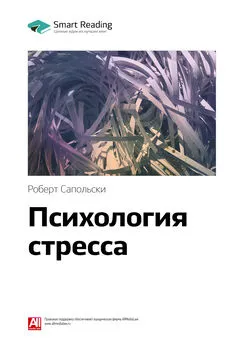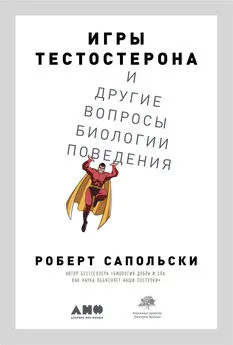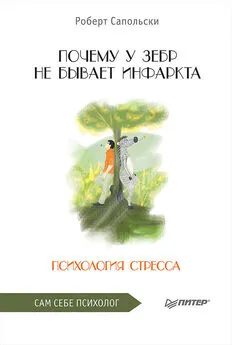Роберт Сапольски - Биология добра и зла. Как наука объясняет наши поступки
- Название:Биология добра и зла. Как наука объясняет наши поступки
- Автор:
- Жанр:
- Издательство:Альпина нон-фикшн
- Год:2019
- Город:Москва
- ISBN:978-5-0013-9051-0
- Рейтинг:
- Избранное:Добавить в избранное
-
Отзывы:
-
Ваша оценка:
Роберт Сапольски - Биология добра и зла. Как наука объясняет наши поступки краткое содержание
Биология добра и зла. Как наука объясняет наши поступки - читать онлайн бесплатно ознакомительный отрывок
Интервал:
Закладка:
566
G. Wilkinson, “Reciprocal Altruism in Bats and Other Mammals,” Ethology and Sociobiology 9 (1988): 85; G. Wilkinson, “Reciprocal Food Sharing in the Vampire Bat,” Nat 308 (1984): 181.
567
W. D. Hamilton, “Geometry for the Selfish Herd,” J Theoretical Biol 31 (1971): 295.
568
R. Trivers, “The Evolution of Reciprocal Altruism,” Quarterly Rev of Biol 46 (1971): 35.
569
R. Seyfarth and D. Cheney, “Grooming, Alliances and Reciprocal Altruism in Vervet Monkeys,” Nat 308 (1984): 541.
570
R. Axelrod and W. D. Hamilton, “The Evolution of Cooperation,” Sci 211 (1981): 1390.
571
M. Nowak and K. Sigmund, “Tit for Tat in Heterogeneous Populations,” Nat 355 (1992): 250; R. Boyd, “Mistakes Allow Evolutionary Stability in the Repeated Prisoner’s Dilemma Game,” J Theoretical Biol 136 (1989): 4756.
572
М. Nowak and R. Highfield, SuperCooperators: Altruism, Evolution, and Why We Need Each Other to Succeed (New York: Simon & Schuster, 2012). К сноске: М. Nowak and K. Sigmund, “A Strategy of Win-Stay, Lose-Shift that Outperforms Tit-for-Tat in the Prisoner’s Dilemma Game,” Nat 364 (1993): 56.
573
E. Fischer, “The Relationship Between Mating System and Simultaneous Hermaphroditism in the Coral Reef Fish, Hypoplectrus nigricans (Serranidae),” Animal Behav 28 (1980): 620.
574
M. Milinski, “Tit for Tat in Sticklebacks and the Evolution of Cooperation,” Nat 325 (1987): 433.
575
C. Packer et al., “Egalitarianism in Female African Lions,” Sci 293 (2001): 690; M. Scantlebury et al., “Energetics Reveals Physiologically Distinct Castes in a Eusocial Mammal,” Nat 440 (2006): 795; R. Heinsohn and C. Packer, “Complex Cooperative Strategies in Group-Territorial African Lions,” Sci 269 (1995): 1260.
576
R. Trivers, “Parent-Offspring Conflict,” Am Zoologist 14 (1974): 249.
577
D. Maestripieri, “Parent-Offspring Conflict in Primates,” Int J Primat 23 (2002): 923.
578
D. Haig, “Genetic Conflicts in Human Pregnancy,” Quartery Rev of Biol 68 (1993): 495; R. Sapolsky, “The War Between Men and Women,” Discover , May 1999, p. 56.
579
S. J. Gould, “Caring Groups and Selfish Genes,” in The Panda’s Thumb: More Reflections in Natural History (London: Penguin Books, 1990), p. 72.
580
S. Okasha, Evolution and the Levels of Selection (Oxford: Clarendon Press, 2006).
581
P. Bijma et al., “Multilevel Selection 1: Quantitative Genetics of Inheritance and Response to Selection,” Genetics 175 (2007): 277. Похожий на ситуацию с курицами пример с пауками: J. Pruitt and C. Goodnight, “Site-Specific Group Selection Drives Locally Adapted Group Compositions,” Nat 514 (2014): 359.
582
S. Bowles, “Conflict: Altruism’s Midwife,” Nat 456 (2008): 326.
583
D. S. Wilson and E. O. Wilson, “Rethinking the Theoretical Foundation of Sociobiology,” Quarterly Rev of Biol 82 (2008): 327.
584
F. de Waal, Our Inner Ape (NY: Penguin, 2005); I. Parker, “Swingers: Bonobos Are Celebrated as Peace-Loving, Matriarchal, and Sexually Liberated. Are They?” New Yorker , July 30, 2007, p. 48; R. Wrangham and D. Peterson, Demonic Males: Apes and the Origins of Human Violence (NY: Houghton Mifflin, 1996); R. Wrangham et al., “Comparative Rates of Violence in Chimpanzees and Humans,” Primates 47 (2006): 14.
585
D. Falk et al., “Brain Shape in Human Microcephalics and Homo floresiensis ,” PNAS 104 (2007): 2513. Противоположная точка зрения: M. Henneberg et al., “Evolved Developmental Homeostasis Disturbed in LB1 from Flores, Indonesia, Denotes Down Syndrome and Not Diagnostic Traits of the Invalid Species Homo floresiensis ,” PNAS 111 (2014): 11967.
586
K. Prufer et al., “The Bonobo Genome Compared with the Chimpanzee and Human Genomes,” Nat 486 (2012): 527; W. Enard et al., “Intra- and Interspecific Variation in Primate Gene Expression Patterns,” Sci 296 (2002): 340.
587
D. Barash and J. Lipton, The Myth of Monogamy: Fidelity and Infidelity in Animals and People (New York: Henry Holt, 2002); B. Chapais, Primeval Kinship: How Pair-Bonding Gave Birth to Human Society (Cambridge, MA: Harvard University Press).
588
T. Zerjal et al., “The Genetic Legacy of the Mongols,” Am J Hum Genetics 72 (2003): 713.
589
M. Daly and M. Wilson, “Evolutionary Social Psychology and Family Homicide,” Sci 242 (1988): 519. Воспроизведение результата: V. Weekes-Shackelford and T. K. Shackelford, “Methods of Filicide: Stepparents and Genetic Parents Kill Differently,” Violence and Victims 19 (2004): 75. Недостаток воспроизведения результата на шведской выборке: H. Temrin et al., “Step-Parents and Infanticide: New Data Contradict Evolutionary Predictions,” Proc Royal Soc B 267 (2000): 943; M. Van Ijzendoorn et al., “Elevated Risk of Child Maltreatment in Families with Stepparents but Not with Adoptive Parents,” Child Maltreatment 14 (2009): 369.; J. Nordlund and H. Temrin, “Do Characteristics of Parental Child Homicide in Sweden Fit Evolutionary Predictions?” Ethology 113 (2007): 1029.
590
K. Hill et al., “Co-residence Patterns in Hunter-Gatherer Societies Show Unique Human Social Structure,” Sci 331 (2011): 1286.
591
R. Topolski et al., “Choosing Between the Emotional Dog and the Rational Pal: A Moral Dilemma with a Tail,” Anthrozoös 26 (2013): 253.
592
B. Thomas et al., “Harming Kin to Save Strangers: Further Evidence for Abnormally Utilitarian Moral Judgments After Ventromedial Prefrontal Damage,” J Cog Nsci 23 (2011): 2186.
593
R. Sapolsky, “Would You Break That Law for Your Family?” Los Angeles Times , November 17, 2013.
594
J. Persico, My Enemy, My Brother: Men and Days of Gettysburg (Cambridge, MA: Da Capo Press, 1996).
595
R. MacMahon, Homicide in Pre-famine and Famine Ireland (Liverpool, UK: Liverpool University Press, 2014). Убийство за чизбургер: J. Berlinger and T. Marco, “Man Kills Brother in Argument over Cheeseburger, Police Say,” CNN.com, May 9, 2016, www.cnn.com/2016/05/08/us/man-allegedly-kills-brother-over-cheeseburger/index.html.
596
К сноске: “MP Comes to the Aid of 5 Year Old Girl at Risk of Being Sold,” Kenya Daily Nation , October 13, 2014, www.nation.co.ke/video/-/1951480/2484684/-/gditgq/-/index.html.
597
S. Friedman and P. Resnick, “Child Murder by Mothers: Patterns and Prevention,” World Psychiatry 6 (2007): 137; S. West, et al., “Fathers Who Kill Their Children: An Analysis of the Literature,” J Forensic Sci 54 (2009): 463; S. B. Hrdy, Mother Nature: A History of Mothers, Infants and Natural Selection (New York: Pantheon, 1999).
598
J. Shepher, “Mate Selection Among Second Generation Kibbutz Adolescents and Adults: Incest Avoidance and Negative Imprinting,” Arch Sexual Behav 1 (1971): 293; A. Wolf, Sexual Attraction and Childhood Association: A Chinese Brief for Edward Westermarck (Palo Alto, CA: Stanford University Press, 1995).
599
K. Hill et al., “Co-residence Patterns in Hunter-Gatherer Societies Show Unique Human Social Structure,” Sci 331 (2011): 1286.
600
N. Eldredge and S. J. Gould, “Punctuated Equilibria: An Alternative to Phyletic Gradualism,” in Models in Paleobiology , ed. T. J. M. Schopf (San Francisco: Freeman Cooper, 1972), p. 82.
601
J. Goldman, “Man’s New Best Friend? A Forgotten Russian Experiment in Fox Domestication,” Sci Am , September 2010; D. Belyaev and L. Trut, “Behaviour and Reproductive Function of Animals. II: Correlated Changes Under Breeding for Tameness,” Bull Moscow Soc of Naturalists B Series (in Russian) 69 (1964): 5.
602
S. Sternthal, “Moscow’s Stray Dogs,” Financial Times , January 16, 2010.
603
К сноске: M. Carneiro et al., “Rabbit Genome Analysis Reveals a Polygenic Basis for Phenotypic Change During Domestication,” Sci 345 (2014): 1074.
604
S. Fisher and M. Ridley, “Culture, Genes, and the Human Revolution,” Sci 340 (2013) 929; D. Swallow, “Genetics of Lactase Persistence and Lactose Intolerance,” Ann Rev of Genetics 37 (2003): 197; J. Troelsen, “Adult-Type Hypolactasia and Regulation of Lactase Expression,” Biochimica et Biophysica Acta 1723 (2005): 19.
605
N. Mekel-Bobrov et al., “Ongoing Adaptive Evolution of ASPM, a Brain Size Determinant in Homo sapiens ,” Sci 309 (2005): 1720.
606
J. Weiner, The Beak of the Finch: A Story of Evolution in Our Time (New York: Knopf, 1994); J. Neel, “Diabetes Mellitus: A ‘Thrifty’ Genotype Rendered Detrimental by ‘Progress’?” Am J Hum Genetics 14 (1962): 353; J. Diamond, “Sweet Death,” Natural History , February 1992. Американские пима против мексиканских: P. Kopelman, “Obesity as a Medical Problem,” Nat 404 (2000): 635. Идентифицированные гены: C. Ezzell, “Fat Times for Obesity Research,” J NIH Research 7 (1995): 39; C. Holden, “Race and Medicine,” Sci 302 (2003): 594; J. Diamond, “The Double Puzzle of Diabetes,” Nat 423 (2003): 599.
607
E. Pennisi, “The Man Who Bottled Evolution,” Sci 342 (2013): 790.
608
S. J. Gould and N. Eldredge, “Punctuated Equilibria: The Tempo and Mode of Evolution Reconsidered,” Paleobiology 3 (1977): 115.
609
P. W. Andrews et al., “Adaptationism – How to Carry Out an Exaptationist Program,” BBS 25 (2002): 489; S. J. Gould and E. S. Vrba, “Exaptation – a Missing Term in the Science of Form,” Paleobiology 8 (1982): 4; A. Figueredo and S. Berry, “‘Just Not So Stories’: Exaptations, Spandrels, and Constraints,” BBS 25 (2002): 517; J. Roney and D. Maestripieri, “The Importance of Comparative and Phylogenetic Analyses in the Study of Adaptation,” BBS 25 (2002): 525.
Читать дальшеИнтервал:
Закладка:

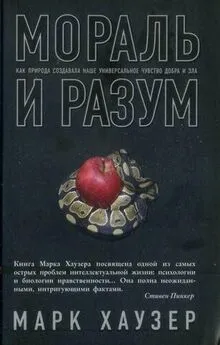
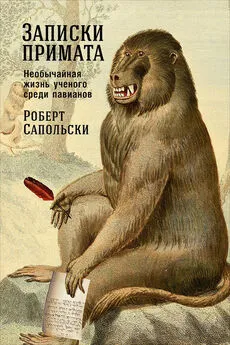


![Роберт Сапольски - Игры тестостерона и другие вопросы биологии поведения [litres]](/books/1074102/robert-sapolski-igry-testosterona-i-drugie-vopros.webp)


